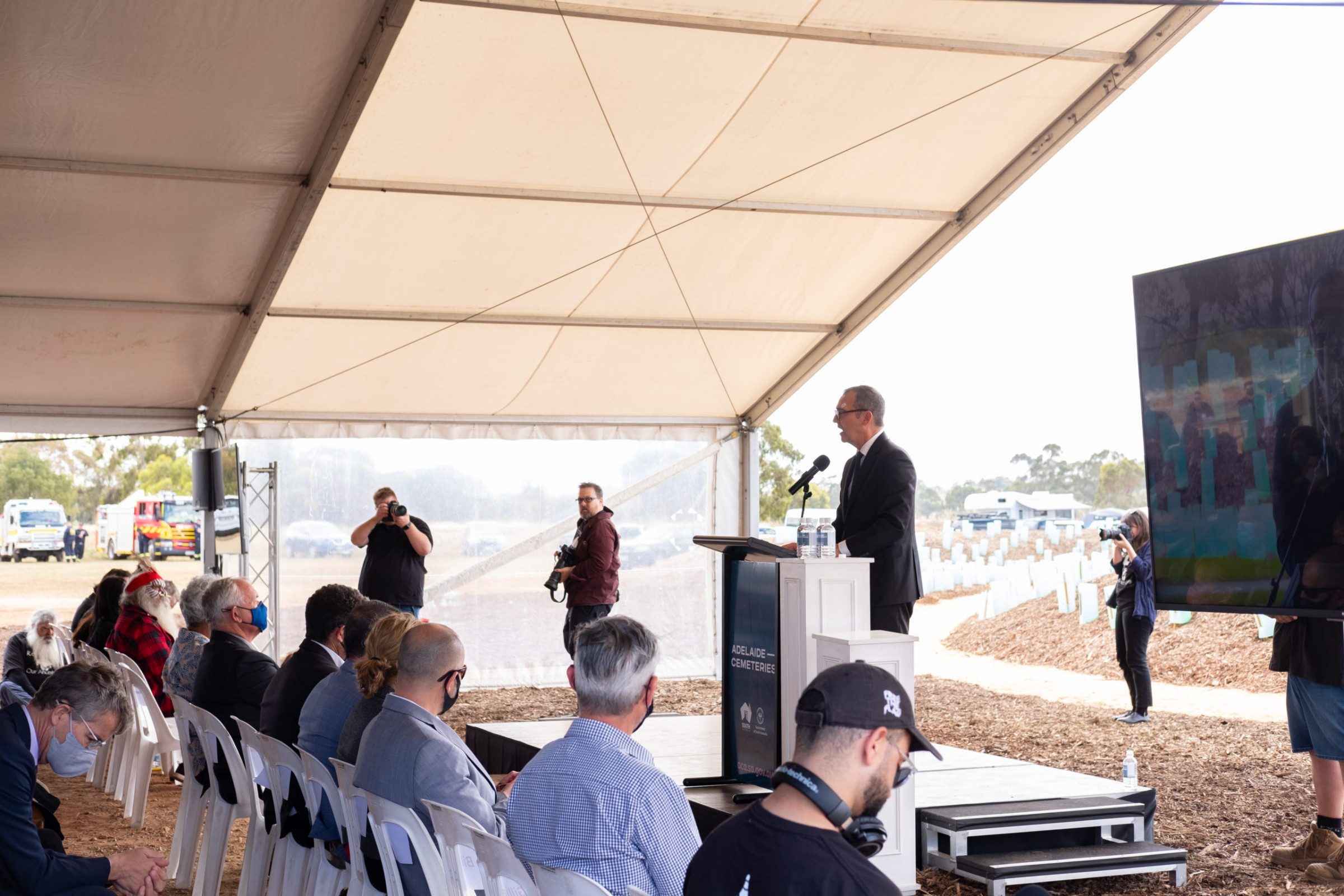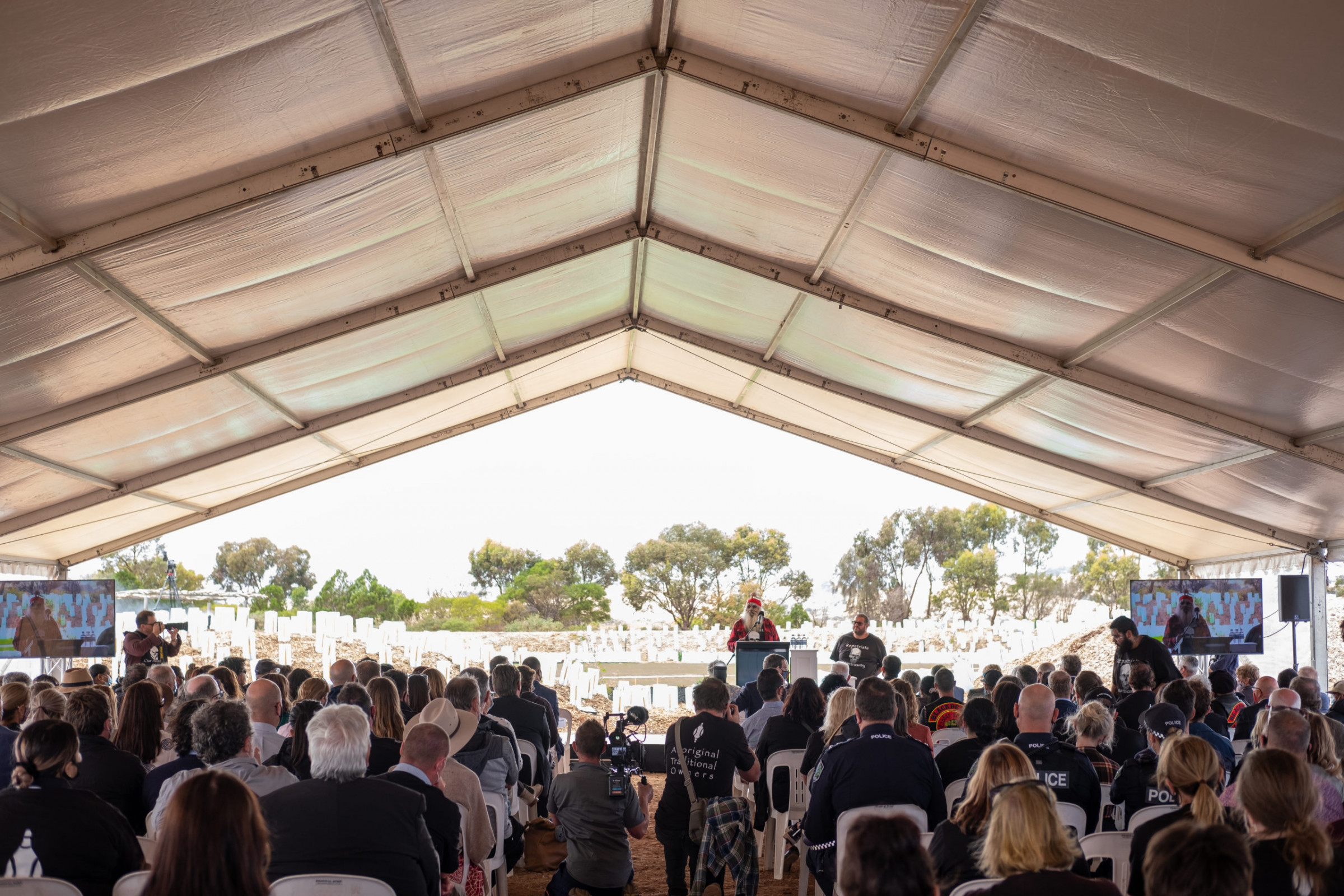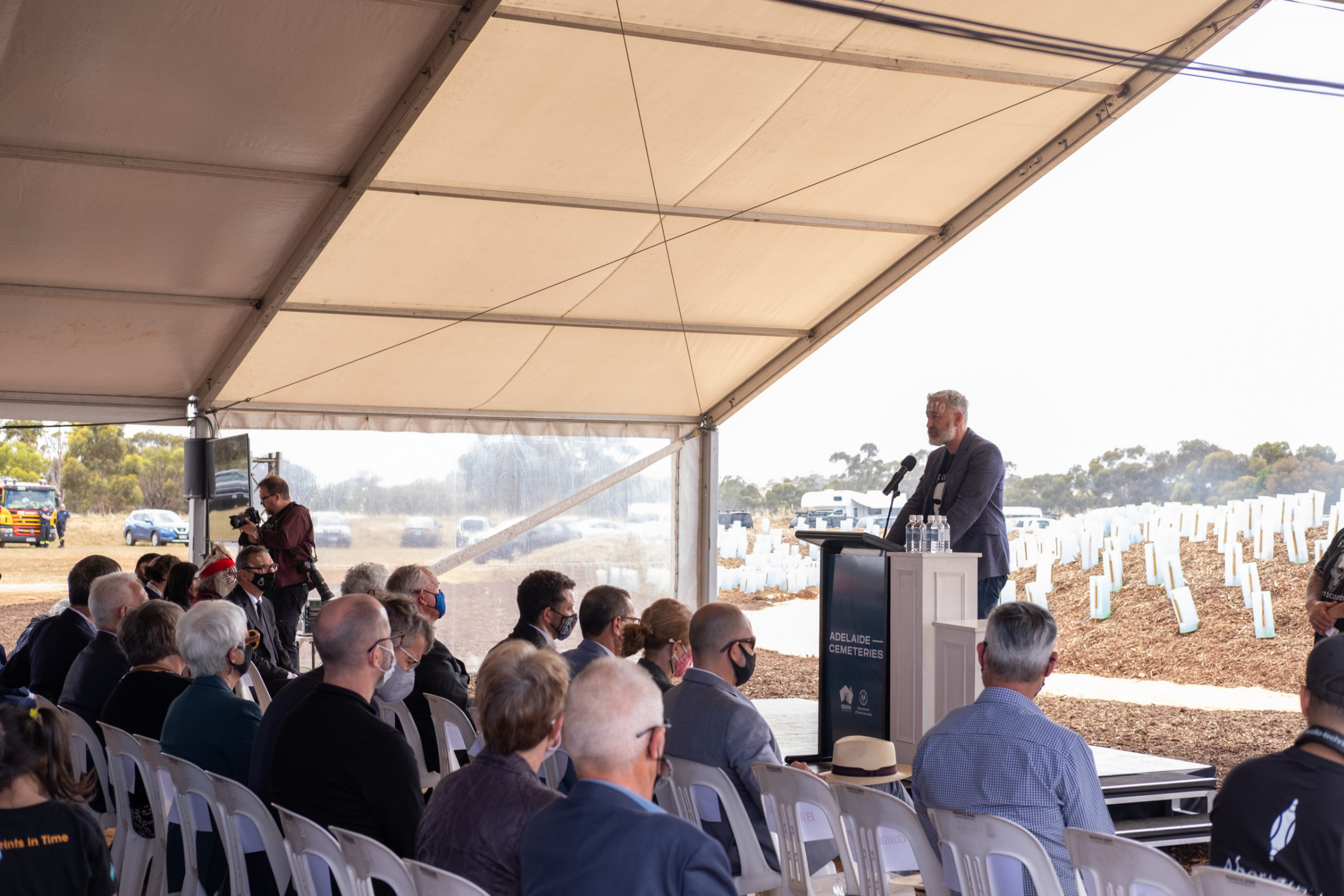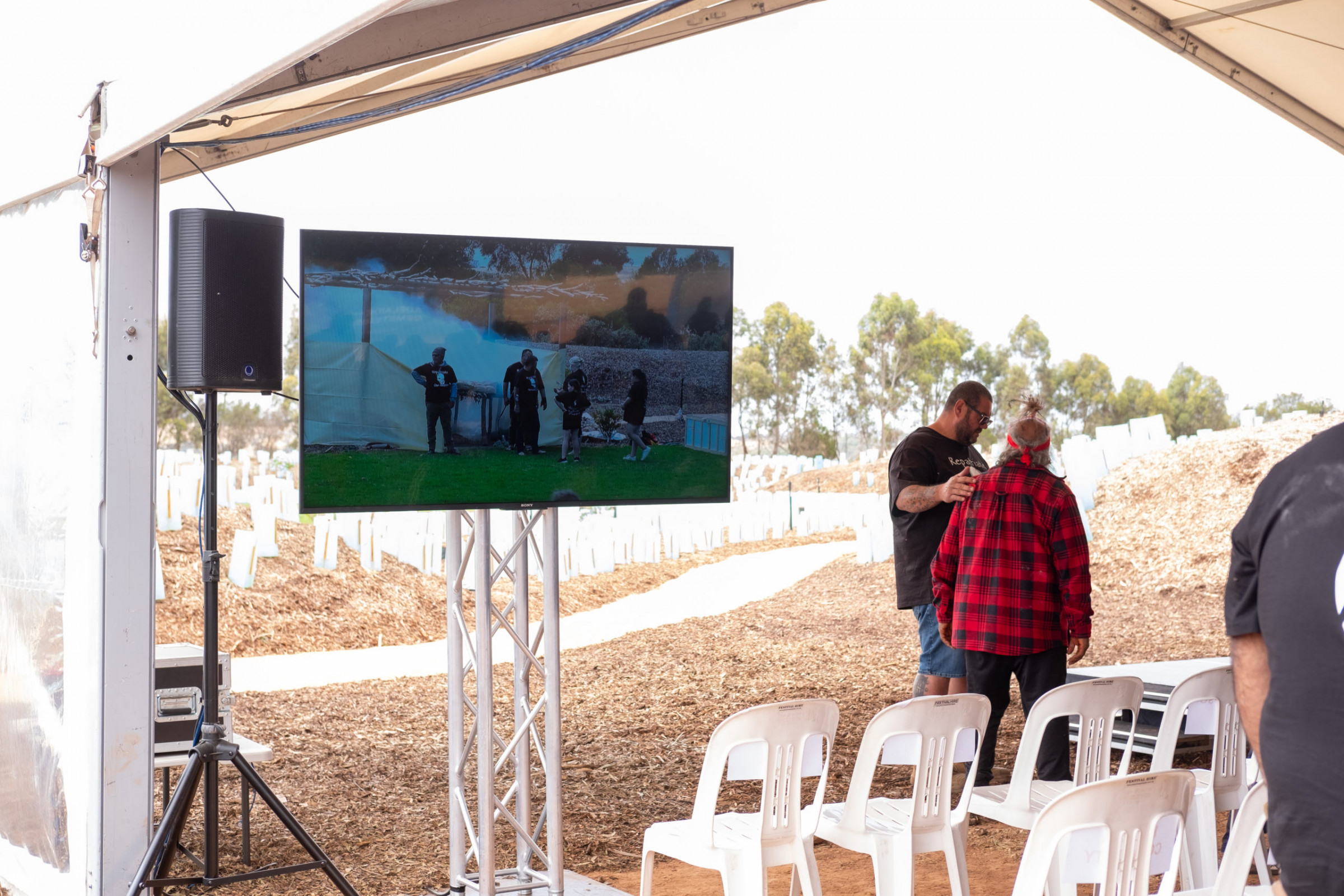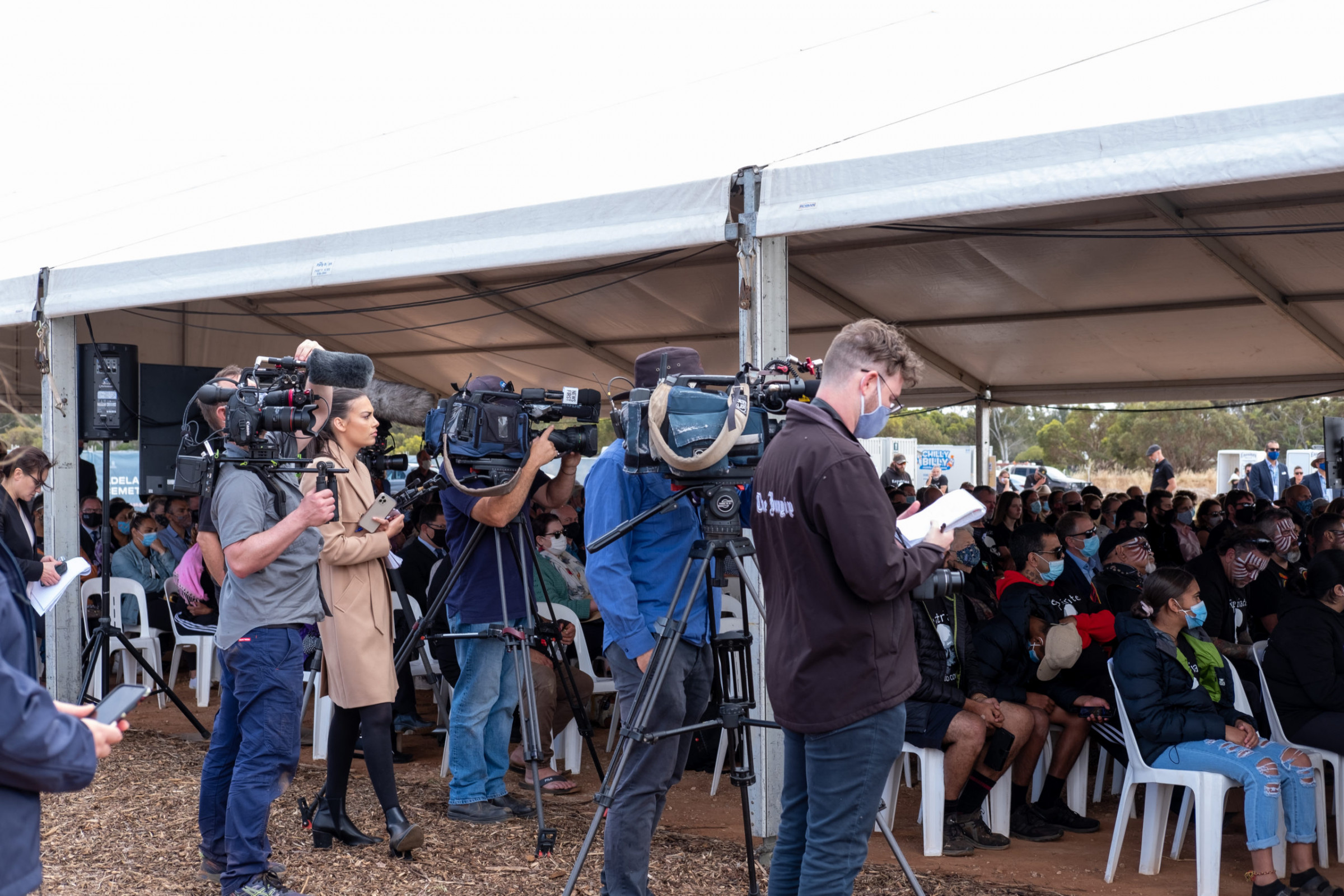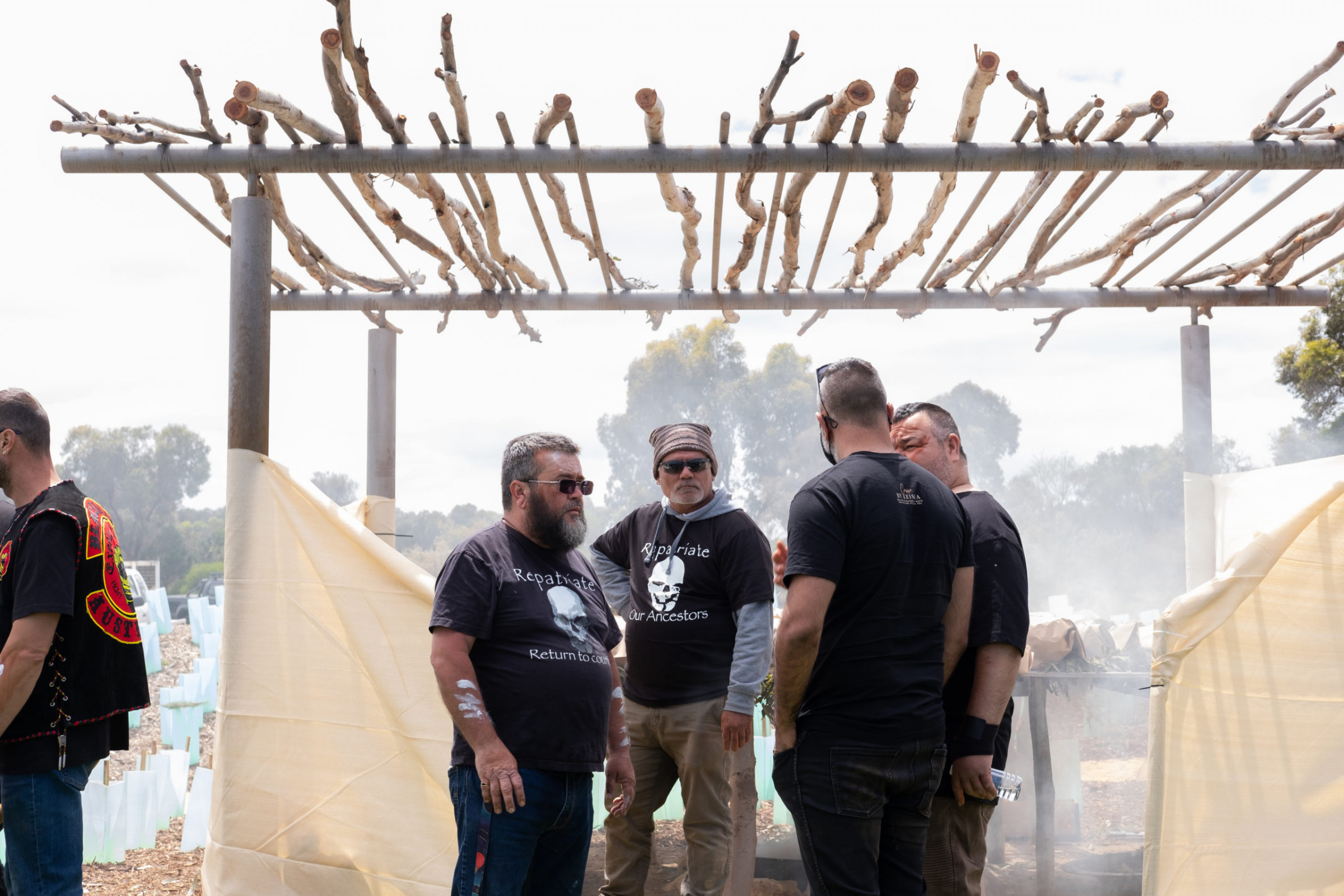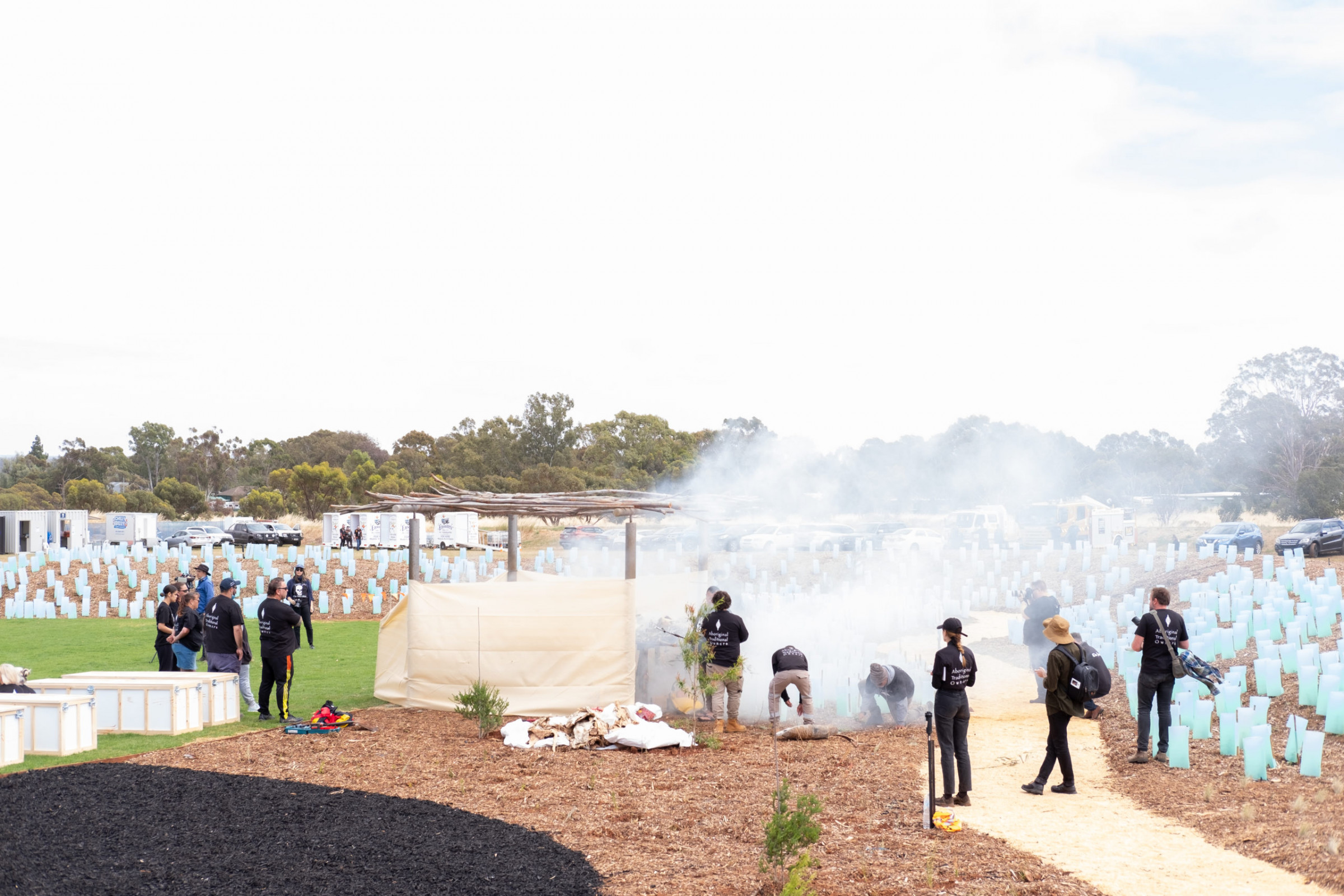The weight of Wangayarta
Words: Angela Skujins
Pictures: Angela Skujins and Johnny von Einem
Additional reporting: Johnny von Einem
A new kind of cemetery, a new kind of ritual.
At Wangayarta, the Kaurna community has established what is being hailed as a world-first memorial site, working in collaboration with the South Australian Museum, Adelaide Cemeteries Authority and State Government.
The night before the historic burial of 130 Old People’s remains, CityMag camped with Kaurna elders and South Australian Museum staff to hear more about the site’s significance.
WARNING: Aboriginal and Torres Strait Islander readers are warned that the following article contains descriptions of deceased Indigenous persons.
—
The morning’s thick cloud cover has given way to a bright afternoon on Tuesday, 7 December, as Kaurna Italian man Mark Catazariti walks towards a large excavated hole. In a slow procession, the remains of 130 Old People, unearthed and collected over hundreds of years, are being returned to soil, wrapped in butchers paper. Mark holds a package in his ochre-stained hands. Despite the gaze of the crowd of onlookers, he doesn’t falter.
These remains have been kept in boxes at the South Australian Museum for decades. To participate in their reburial is a heavy responsibility, Mark says. But it’s also an honour. In 15 steps, Mark carries the bundled bones from the platform where a smoke ceremony was performed to the open gravesite. He thinks of how his forebears came to be in this situation.
“Obviously, it’s very important, what you’re carrying there,” he tells CityMag afterwards. “Very delicate to hold one of them packages, and also to be placing it down.

Kaurna Elder Mulla Sumner carrying an ancestor
“Was wondering what’s in [the package] and what sort of damage has been done to it.”
Some skeletal remains are incomplete or have been damaged by machinery used for land clearing during the process of building metropolitan Adelaide. Others – including the tiniest of parcels, reserved for the youngest of Kaurna – bear marks of violence.
These remains signify the darkest side of colonisation. Some tell a story of European settlers arriving in Australia and killing Aboriginal people, while others are the result of the continuing urbanisation of the Tarntanya Adelaide Plains – home of Kaurna Miyurna people for 50,000 years.
In a speech prior to the reburial, Kaurna Ngarrindjeri and Yankunytjatjara person Allan Sumner laments the necessity of the day’s events, but says the spirits now settled in the soil are “free”.
“In 1788, devastation [was brought] upon our people,” he says. “It’s an awful history and one that the government has always swept under the carpet.
“[But] there’s an opportunity to come together to heal together on this journey.”
Mark is one of about 20 Kaurna men and women selected to carry ancestors to their final resting place at Kaurna Wangayarta Smithfield Memorial Park, known as Wangayarta. He feels a wave of relief placing his final parcel in the ground. His ancestors will now be here forever.
The Wangayarta site is a 2ha cemetery in the northern suburbs, designed by a reference group comprised of Uncle Jeffrey Newchurch, Aunty Heather Agius, Uncle Major ‘Moogy’ Sumner, Aunty Merle Simpson, Aunty Rosalind Coleman, Aunty Madge Wanganeen, Allan Sumner, Ali Abdullah-Highfold and Tania Taylor. The design was brought to life by landscape architects Oxigen.
Integral to the site’s completion was $300,000 in State Government funding, combined with the support of Kaurna Yerta Aboriginal Corporation, the South Australian Museum, Adelaide Cemeteries and the Department of the Premier and Cabinet.
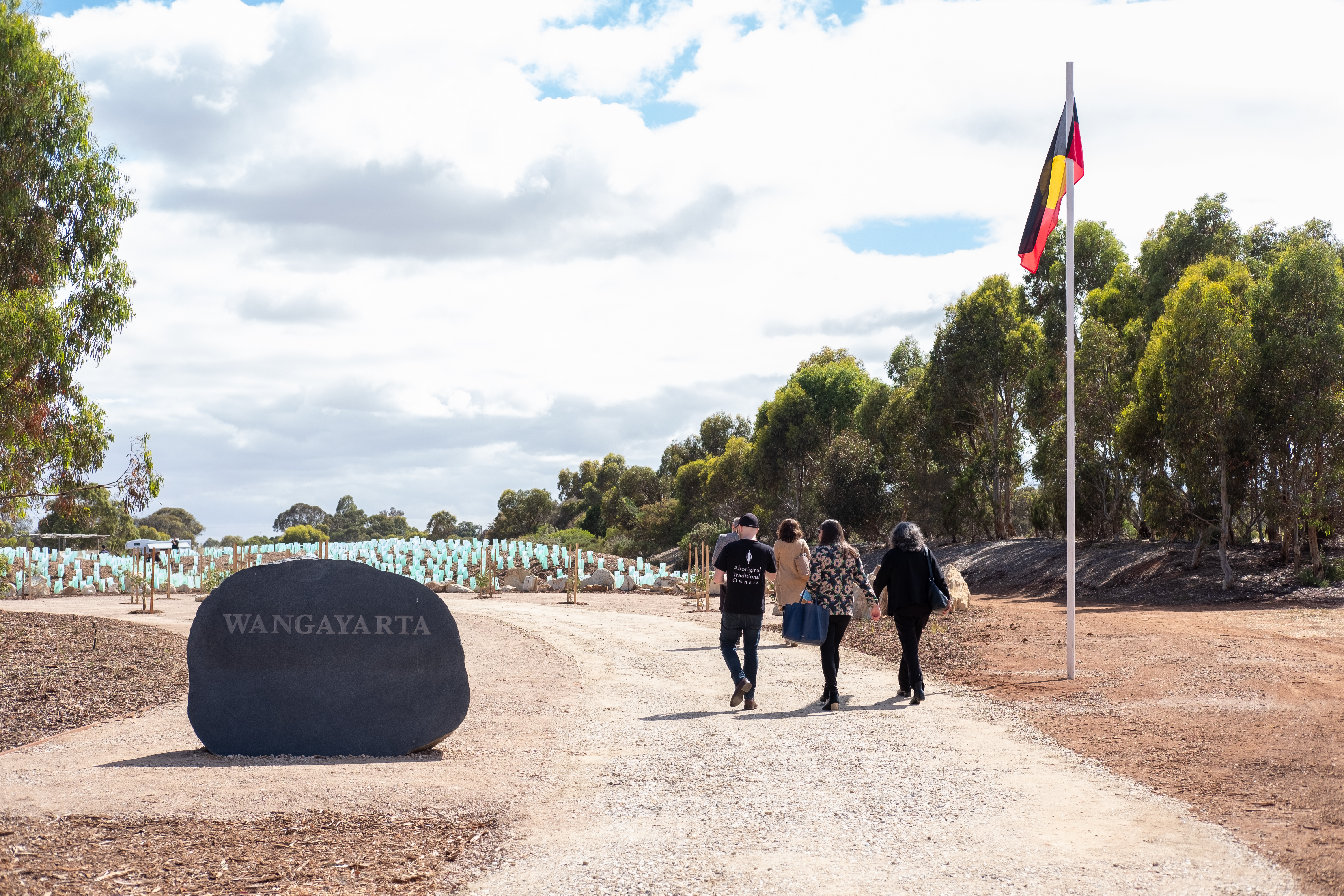
Kaurna Wangayarta Smithfield Memorial Park
More important though are the decades of unshakable Aboriginal nerve in pursuing a permanent solution to the seemingly interminable issue of disturbed burial sites and unearthed First Nations remains. According to Uncle Jeffrey, at least one Kaurna burial site is uncovered in metropolitan Adelaide every year.
Wangayarta was constructed to accommodate the remains of thousands of Kaurna ancestors already dug up in the process of Adelaide’s urban sprawl, as well as those whose eternal slumber will sadly, at some point, be interrupted.
Roughly 4500 Aboriginal remains are stored at the South Australian Museum’s Netley warehouse. Some of these remains came into the museum’s possession through removals that occurred in the late 19th century. The South Australian Museum and the University of Adelaide exhumed some remains to be studied and documented. The museum also receives newly excavated bones, found in the process of land clearing and construction. The people who find them simply don’t know what else to do with them.
The oldest Kaurna remains stored at the museum belong to a 130-year-old Kaurna Elder. These are the first laid to rest at Wangayarta.
“He was known as one of the first Kaurna men to be taken to the South Australian Museum,” Allan explains. “Not all of his remains are here with us today.”
As the procession draws to a close, Mark and his mentor, Kaurna Elder Mulla Sumner, make a slow, percussive beat with long clapping sticks, at either end of the burial site. “It’s an ancestor’s calling,” Mark explains of the dirge. “It’s part of the tradition.”

THE NIGHT BEFORE
Late on Monday afternoon, CityMag pulls up to the dry, dusty site surrounding the burial ground. We’ve been invited to camp with the Kaurna community and South Australian Museum staff the night before the burial. We’re immediately blown away by Wangayarta’s immensity.
The cemetery sits on top of a hill with a vast view towards the city below. The large diamond-shaped allotment, designed to resemble a Kaurna shield, has four quadrants – the north, east, south and west burial grounds. Three segments are covered in black wood chips, but the northern plot, which will be used tomorrow, is empty.
There are different heights and vegetation types within the site, undulating like waves in the ocean. We’re told a special soil ceremony has already taken place at Wangayarta. The ground crunching beneath our shoes includes earth collected from all corners of Tarntanya Adelaide Plains, so that all anscestors can sleep together.
The young plants and trees dotted throughout the site are protected by moss-coloured mesh. Although it’s not very leafy now, Kaurna and Ngarrindjeri person Major ‘Moogy’ Sumner expects the site will soon resemble the Garden of Eden when the plants mature.
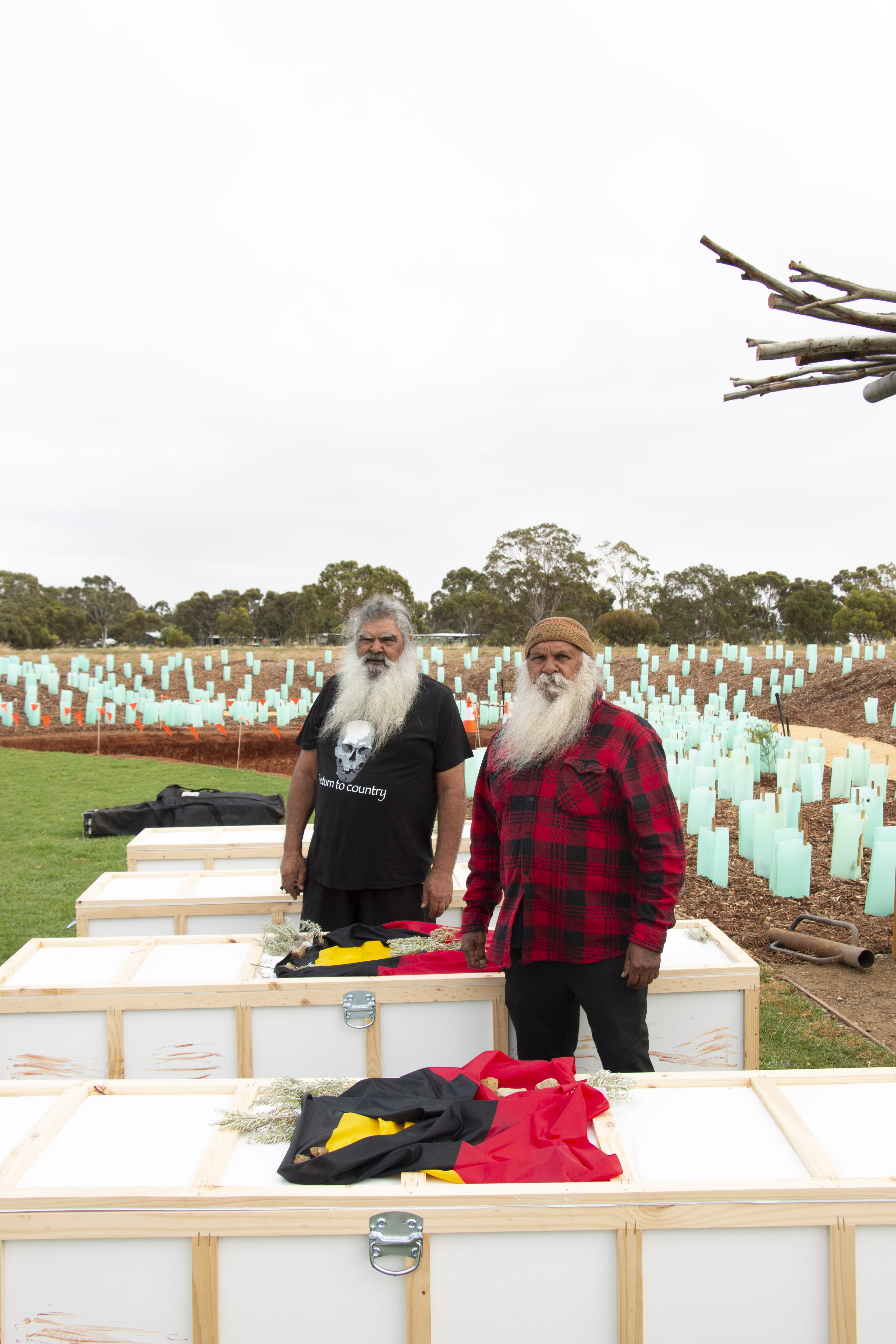
L—R: Uncle Jeffrey Newchurch and Uncle Major ‘Moogy’ Sumner
“The shape is a shield – the Kaurna shield,” he says.
“The shield is to protect, so we protect this area.”
Uncle Moogy has repatriated Aboriginal remains for 40 years, travelling overseas to countries like Germany and Britain to bring his ancestors home. On these solemn voyages, he often sings and talks to the Old People, keeping them company.
A respected Elder (and acclaimed thespian), Uncle Moogy says he has a close relationship with some of the remains secured in five long, wooden crates in front of us. His mother is Kaurna, so some of these people are distant relatives.
“All the people here would be related to me and other Kaurna people here in some way or another,” he says.
But not all of them got to experience life.
“A lot of them are children. A lot of them are little babies. A lot of them are adults,” Uncle Moogy says.
“Even just by the size of some the leg bones and that, [you can tell] they were very tall people. When you look at it that way, some of them had a good life, they lived a long life. But others, they never seen life and that’s really sad.”
Each crate has an Aboriginal Flag draped over it, with strands of saltbush placed on top. Uncle Moogy says native flora such as this, and other types used for bush medicine and ceremonies, are planted around the site. All the plants required for future ceremonies will eventually be able to be sourced from Wangayarta.
There are also rocks on top of the flags, placed around the saltbush. We ask Uncle Moogy if these objects, too, hold significance. Picking up a stone and holding it in his hands, he looks into our eyes with a firm, serious gaze. “They’re placed on the Aboriginal flags,” he says, pausing pensively, “to stop them from blowing away.” His face cracks and together, beside the remains of his family, we laugh.
Back on the red dirt outside the burial site, there are two platforms constructed of pink pallets bolted to legs made from found timber. Tomorrow, these waist-height structures will hold the ancestors as they’re smoked from below, before the remains are carried into the northern burial hole. The pallets need to be painted black before the ceremony though, which is a job John Carty, head of humanities at the South Australian Museum, has delegated to CityMag. We dutifully oblige.
As thanks for a job well done, CEO of Adelaide Cemeteries Authority, Robert Pitt, offers us watermelon slices. He says it has been a privilege to participate in this “history-in-the-making” event. For him, it will be a career milestone.
As the paint dries, John introduces us to Travis Thomas. Travis is a Nukunu person, co-chair of the First Nations of South Australia Aboriginal Corporation, a captain with the South Australian Country Fire Service and director of the Nukunu Wampa Thura Aboriginal Corporation.

Travis’ CFS brigade, accompanied by a Metropolitan Fire Service appliance, is stationed at Wangayarta to make sure the evening’s campfires don’t become bushfires.
Seeing a project like Wangayarta come to fruition is meaningful for Travis, as he’s aware of the effort required to make change within large organisations. Often, initiatives will stall in motion. Bureaucracy masquerading as progress.
“We see a lot of businesses and agencies creating things like reconciliation action plans; there’s lots of glossy brochures and writing,” he says, looking over the field.
“But the key is the term ‘action’, and this (Wangayarta) is an action.
“It’s an act. It’s an action with a result, which is a meaningful result. And we can see that that is also enabling these First Nations to reconnect with that culture and meet their cultural obligations here.”
We ask Travis how he sees this landscape, given the many perspectives he brings to this site. There is more First Nations knowledge that could be implemented more broadly at Wangayarta, he says.
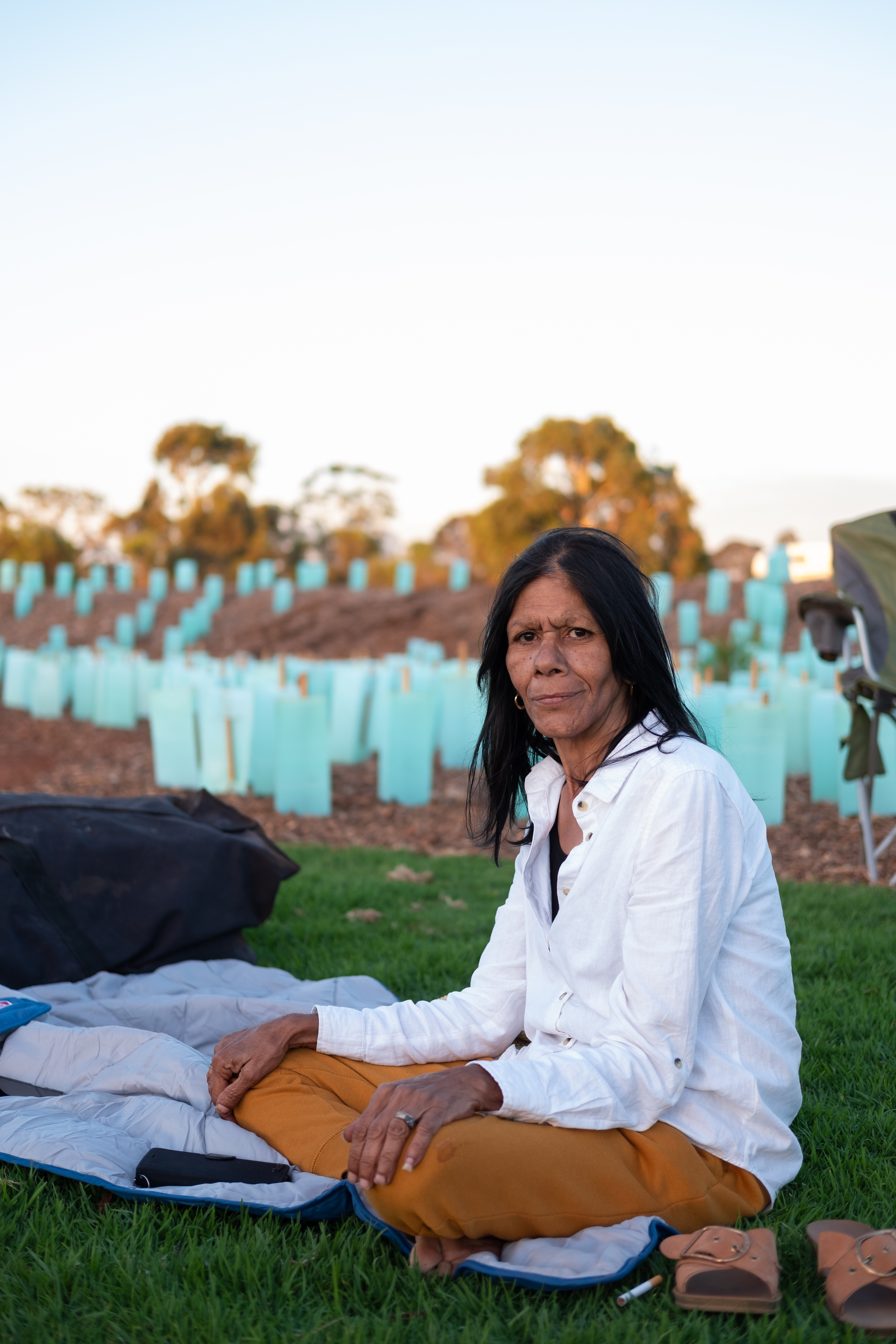
Aunty Madge Wanganeen
“This is a heavily influenced landscape, so it’s obviously been impacted through settlement. It’s not in a natural state,” he says.
Managed correctly, with First Nations knowledge of fire-stick farming, there is opportunity here to “clean up Country” and take care of the land.
Water coasting on the breeze from a sprinkler operating nearby dapples onto our faces as we speak. We share a chuckle.
On the other side of the mound, Aunty Madge Wanganeen – South Australian Museum’s repatriation officer and a respected Kaurna Elder – sits on the grass on an unzipped sleeping bag. With a cigarette between her fingers, she admits to “shaking” thinking about the gravity of tomorrow’s event.
“I’ve been doing [repatriations] for a while, for about 20 years, and this is a huge reburial, [the largest] that I’ve ever had to deal with,” Aunty Madge says. She accompanied the remains in a hearse as they were driven from Netley to Wangayarta this morning.
“Wrapping my ancestors has been a very emotional time for me. Taking them from Netley today was very emotional for me. [I] nurtured them, looked up to them and talked to them, and now bringing them here and laying them to rest.
“It’s going to be the most privileged thing that I’ve ever done – apart from having children.”
We can hear Aunty Madge’s brood in the distance. One of her grandkids pulled a dirt bike out from a Hilux truck, riding the vehicle up and down a small embankment, tossing dirt into the air.
Aunty Madge says the kids feel great today, and tomorrow they will have dignity. “I’ve got a six-month-old granddaughter to a 20-year-old that’s here with me today, and they’re not frightened,” she says.
“They came up and they looked at the boxes, and they’re able to help make this process work too.
“When Nana got up this morning, and when we brought [the remains] back here, that made them feel great to know that I was in that hearse bringing them home.”

The sun disappears behind the city, and all the campers – a motley crew of museum staff, Native Title workers, Kaurna family and two CityMag reporters – flock to the campfire like bugs to a light.
John is stoking the flames, rolling over the larger pieces of wood. He has positioned five cold sausage rolls onto one of the logs in an attempt to reheat them. It’s a culinary experiment, he says with wink. “Smoked sausage roll.”
As the stars above us twinkle, Uncle Moogy shares stories about his childhood as a displaced First Nations person. At 13, he was separated from his family because of Australian assimilation policies. He was sent to live in Millicent, in regional South Australia, and after that he was shipped off to a boys home in Semaphore.
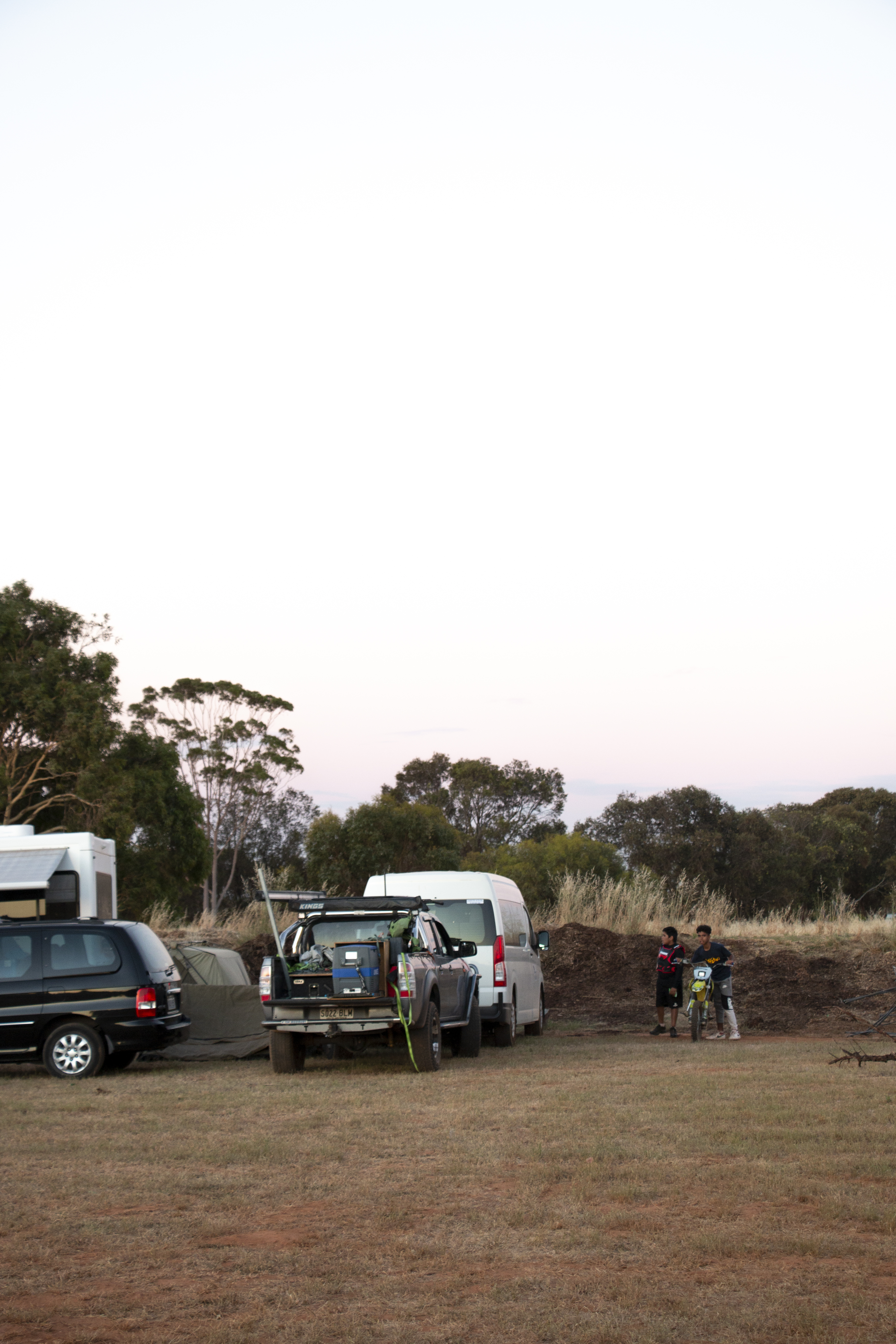
Aunty Madge’s brood
Against his wishes, it seems, he’s always been on the move.
Uncle Moogy says he doesn’t plan on being buried in Wangayarta. He wants his final resting place to be in Ngarrindjeri Country, on the Coorong, with his father, who’s currently buried in a grave site with three other bodies in West Terrace Cemetery.
It’s common for people in Aboriginal communities to be unable to afford cemetery fees, leaving them to lie in unmarked and unregistered graves.
Uncle Moogy is confident Robert Pitt will help his father return to Country. Robert has already helped him find his father’s grave, he says, and he’s leased a parcel of coastal Coorong land from the Aboriginal Lands Trust.
“I’d like to… take [my father] back there,” Uncle Moogy says.
John says he and Uncle Moogy will wake up at the crack of dawn tomorrow to collect eucalyptus leaves for the smoking ceremony. He’s delighted to be granted permission to kick the CityMag reporters’ swags before heading out, so we don’t miss anything.
Before our evening around the fire ends, we ask Aunty Madge’s grandkids if they know any good ghost stories. In the light of the glowing embers, with cups of peppermint tea in hand, we’re spun tales of ancient spirits, called mamus, lurking in trees, and smaller imps with spiky hair crouching behind rocks.
The general gist, CityMag understands, is that you should run when you see these beings. We ask the grandkids if it’s possible to outrun them. They howl with laughter. It’s not possible. You can’t outrun these ghosts.

FIRST LIGHT

Fire from the night before
At 6am, we wake to a gentle shower of morning rain. Uncle Moogy and John ready the funeral pyre next to the crates. Uncle Moogy says he’s feeling something in this gut. This is ‘miwi’, and it can be good or bad. On this occasion, it’s good.
John dries his dirt-covered feet near the remnants of last night’s fire. He says he’s nervous about delivering one of the speeches at today’s event. At around 10:30am Premier Steven Marshall is expected to appear at Wangayarta, with speeches slated for an hour after that.
Individually, John and Uncle Moogy bring into the Wangayarta project two very different histories. On this day, one is a symbol of Aboriginal culture, the other a representative of an institution of colonial Australia. They start collecting twigs and branches for the smoking ceremony, an ancient custom designed to cleanse people or places of negative energy. Together, they are emblematic of a new kind of relationship between their two communities.
We see reverence for this moment in John’s eyes, but at a deeper level we also detect concern. He is, after all, representing both the museum and the University of Adelaide on this day. He lights the fire beneath the pyre. The plants catch alight, casting out small plumes of smoke.
A short time later, media descends. Motorbikes, cars and buses pull in. Drones fly overhead. Reporters steal away Kaurna leaders for interviews. We notice Kaurna Elder Uncle Jeffrey Newchurch arrive.
He throws us a ‘Repatriate’ t-shirt, which has a skull printed on it. The shirts are an education tool to make people aware of the reality of the history that has led to this day.
We take a seat with Uncle Jeffrey inside a white minivan. Today is an emotional day, he says, as all repatriations are.
“I feel a bit uncomfortable,” Uncle Jeffrey says.
“Leading up to this, [it] hadn’t been an easy road.”

Darren Wanganeen
Uncle Jeffery is chair of Kaurna Yerta Aboriginal Corporation (KYAC) and one of the leaders responsible for Wangayarta coming into being. He’s worked on repatriation sites in the past, often dealing with the dead when there was little funding afforded to help the process.
Over the last decade, Uncle Jeffrey has spoken with representatives from different government bodies to try and find a permanent resting place for Kaurna, as Wangayarta has now become. Upon hearing of Uncle Jeffrey’s search, Cemeteries boss Robert offered up this plot of land.
Even as preparations for the first burial on Wangayarta take place, Uncle Jeffrey is cautious. He says he’s “unsure” where KYAC sits with Wangayarta, despite “always being part of the [repatriation] conversation.”
“I’m always there,” Uncle Jeffrey says.
“When one looks at why those old people were placed in museums and for what reason… others have benefitted.
“[But] we certainly haven’t.”
From within the minivan, Uncle Jeffrey looks out across the memorial site. Wangayarta is necessary because of the construction of Adelaide, he says. It also accounts for a “dark” history of colonial institutions stealing, trading and studying Aboriginal people. He wonders if this 2ha plot is adequate when accounted against the generations of ongoing harms.
“Is it recompense?” he muses. “But certainly for us, it’s a beauty because we get land to bury them.”
Back on Wangayarta, Uncle Moogy emerges from a demountable with ochre painted across his face. He’s joined by burly Kaurna men who have opened the crates and are emptying the wrapped ancestors from an assortment of boxes. One by one, Uncle Moogy places them on the pyre.

As the spirits are smoked, we’re called over to a large marquee, filled with hundreds of plastic chairs. The public slowly take their seats. A range of dignitaries speak, offering condolences and their own views on the necessity of a place like Wangayarta. Premier Steven Marshall says repatriation is the responsibility of all South Australians.
“Our lives here as South Australians are built on the historic disturbance of Aboriginal Country,” he says to the silent crowd.
“Those activities destroyed Aboriginal burial sites across the greater Adelaide area to create houses and the infrastructure that we now use.
“Reburial itself is a new process and a new ceremony.”
Now wearing a blazer and shoes, John delivers an emotional speech on behalf of the North Terrace museum and university. He echoes the sentiment of the Premier, but also offers something more direct – an apology. Each “sorry” takes a piece of his composure, his voice wavering.
“My Kaurna brothers and sisters here today, I say sorry,” he says, wiping away a tear.
“I’m sorry on behalf of the museum and on behalf of the university.
“I’m sorry on behalf of all of us. I’m sorry that our forebears did not treat your ancestors as brothers and sisters.”
After the ceremony, John hugs his family for a very long time.
Later, we try to speak with John about his speech and his thoughts on the role the museum has played in this story. He suggests instead we speak to chair of the South Australian Museum, Kim Cheater, who is wearing a crisp navy suit and has a face mask wrapped around his wrist.
“Today’s the day where we can’t fix the past, but we can actually walk a different path together into the future,” Kim says.
Although the museum no longer actively collects the bones of Aboriginal people, it still has thousands of Old People in storage; and that number is growing. When Aboriginal burial sites are disturbed contemporarily, the remains still find their way to the museum simply because there is no other agency or government department designed to store them.
Kim says he doesn’t want the museum to have this responsibility.
“The day that the museum doesn’t have any ancestors and doesn’t need to have any ancestors will be an important day,” he says.
Aunty Madge, Uncle Moogy and Premier Steven Marshall lead a procession back onto Wangayarta for the reburial. They’re followed by the public, who watch young Kaurna people, mentors and elders delicately carry the remains of ancestors from the funeral pyre to the burial site. This is the beginning of the end.
Once all the packages are placed on the soil, the public are invited to walk around the burial site and offer their condolences.
After our journey around the plot, we find Aunty Madge standing by herself, sipping on juice. She says she’s feeling “on top of the world”, but she’s still shaking. This is not the end of her journey.
“There’s more to do, and I know that it’s going to happen because we’ve got the support of our community, and having everybody here today has just made it so real,” she says.
“I love what happened today. It’s been really hard for me as an individual Kaurna woman, but today has made it complete.”
After the politicians, public and media leave, we speak again with Kaurna Italian man Mark, who echoes Aunty Madge’s sentiment.
“There is more to come,” he says, as the Wangayarta site around us finally calms.
Only a small portion of the South Australian Museum’s remains collection has been laid down today. But this beginning is enough for Mark. He knows how much effort has been invested by his ancestors, living and dead, for this to have happened.
“I’ll be walking away with my head high,” he says.

